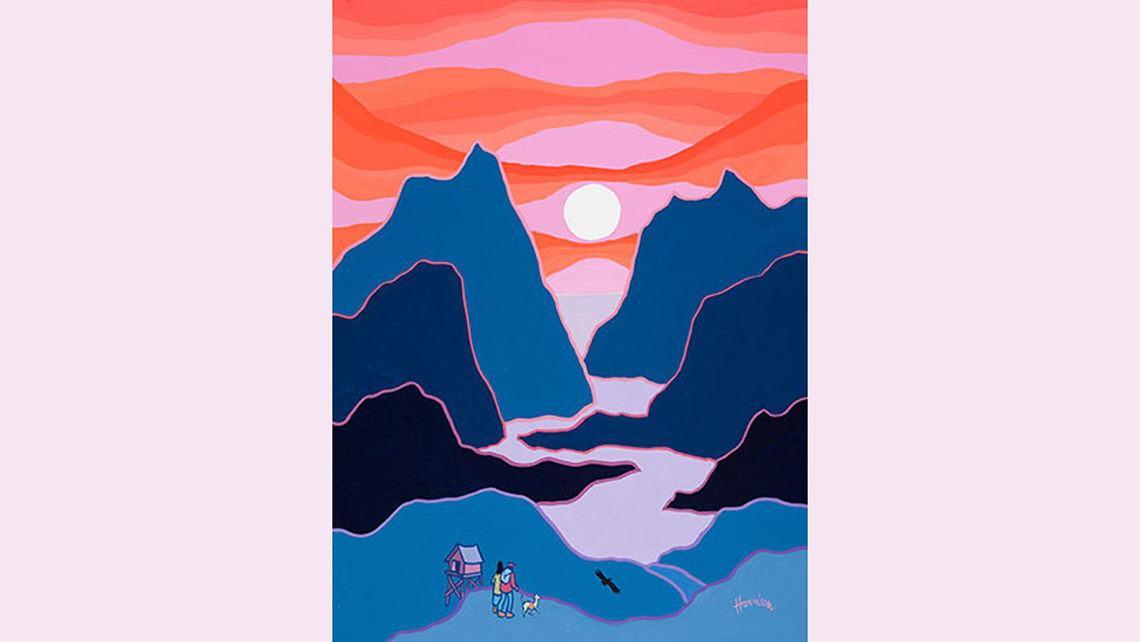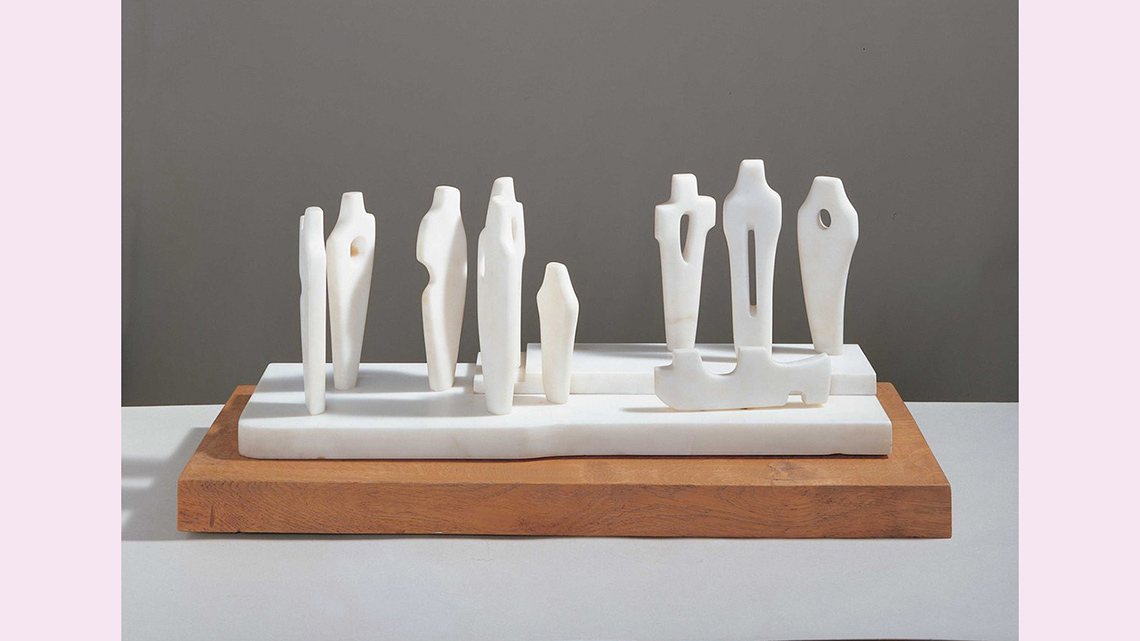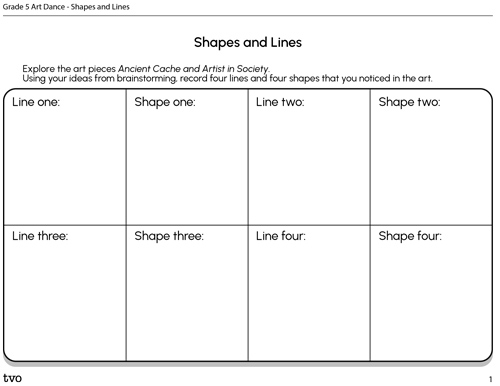Minds On
Today’s vocabulary
Let’s get started!
Other subject areas can inspire dance sequences. We can use movement to express our understanding of different subjects.
Consider the following painting, Ancient Cache by Ted Harrison.
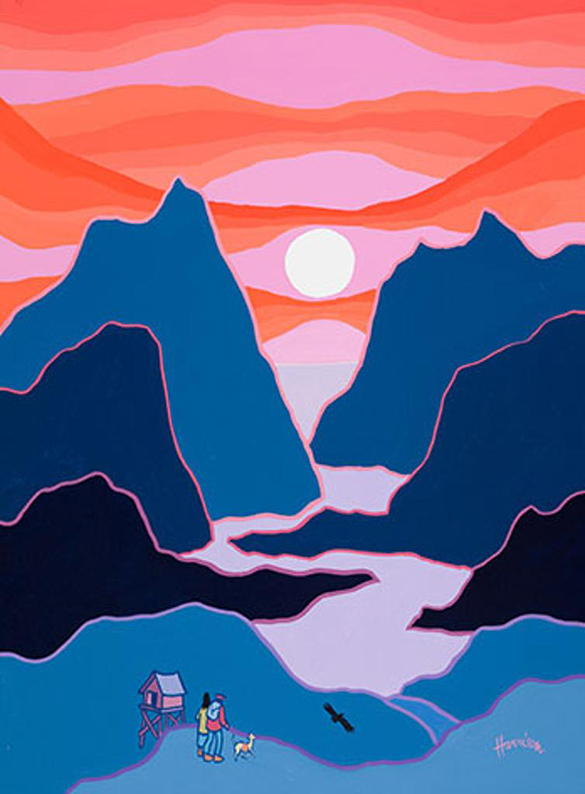
Ancient Cache by Ted Harrison, 1990
The painting is of a mountain landscape. The sky is made with brightly coloured horizontal curved lines. The mountains are darker shades and made of different sized, slightly jagged, curved lines. A small house, two people and a dog are in the foreground.
What types of lines are used in Harrison’s artwork? Brainstorm your ideas using words, pictures, or another method of your choice.
You can use the following Lines in Art chart to guide you.

Types of lines: There are five types of lines: vertical lines that go up and down, horizontal lines that go side-to-side, diagonal lines that go on a slant, zigzag lines that are jagged and squiggly, and curved lines that bend.
Elements of lines: There are five elements of lines. Length describes how long or short a line is. Width describes how thin or thick a line is. Weight describes how thin or thick a line is in different sections of the line. Texture describes how smooth or rough a line is. Finally, style describes if the line is solid, dotted, or dashed.
Let’s think about another piece of art.
Consider the following image of the sculptures Group III (Evocation) by Barbara Hepworth.
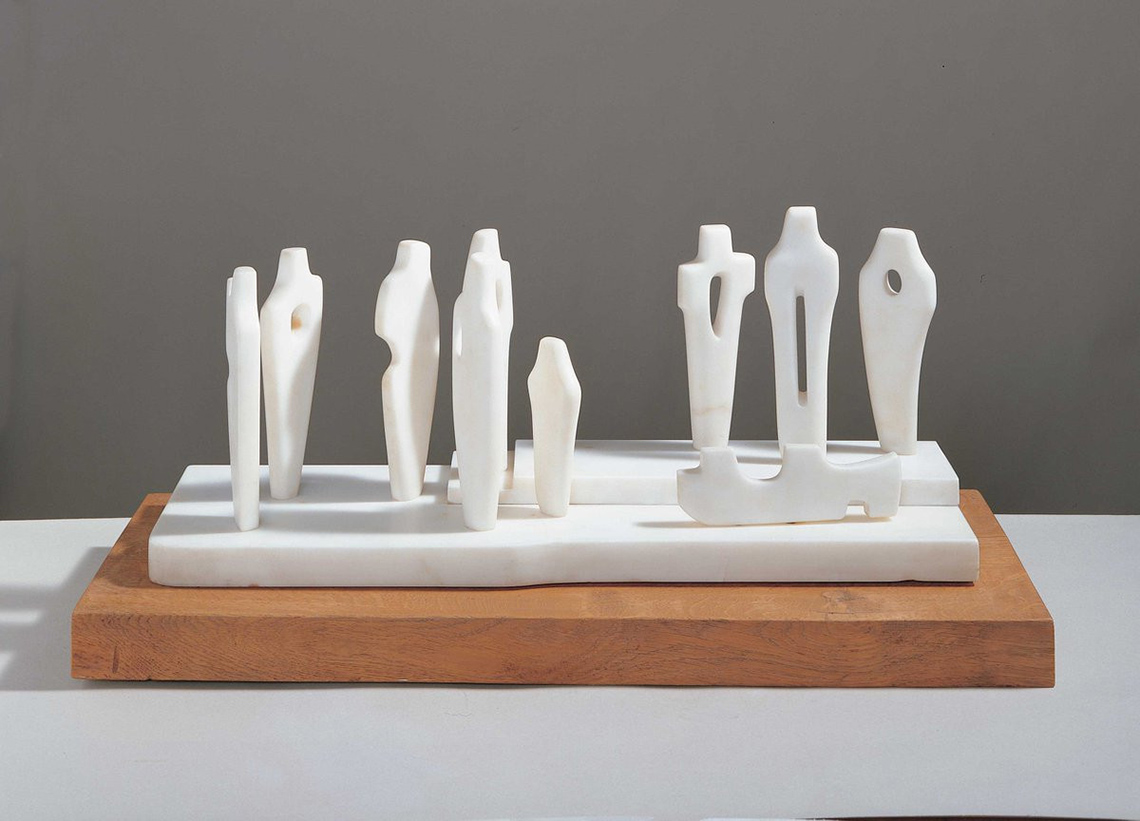
Group III (Evocation) by Barbara Hepworth, 1952
What shapes are being used in this work of art? Brainstorm your ideas using words or images.
Use the following Organic and Geometric Shapes chart to help guide you.

There are two sections on this chart. One section is titled “Geometric shapes” and the other section is titled “Organic shapes.”
In the Geometric shapes section, there are 8 shapes. There is a triangle, which has 3 sides. There is a rectangle, which has 2 long sides and 2 short sides. There is an octagon, which has 8 sides. There is a diamond, which has 4 sides. There is an oval, which is round and stretched out. There is a hexagon, which has 6 sides. There is a square, which has 4 equal sides. Finally, there is a circle, which is a round shape.
In the Organic shapes section, there are 8 shapes. They are not labelled with names and are not shapes that we recognize. These shapes are like blobs. Some of these shapes are long and stretched out and some are short. They do not have straight lines or corners like the shapes in the “geometric” section.
Action
Get ready, get set…
Task 1: Examining art
Let’s revisit the images and descriptions of the art pieces from the Minds On section. We’re going to explore translating the elements of art (line and shape) into movement.
We will start by selecting four lines from the painting and four shapes from the sculpture that you noticed while brainstorming.
Here are the art pieces again:
A carousel of two images.
Image 1: Ancient Cache by Ted Harrison, 1990. The painting is of a mountain landscape. The sky is made with brightly coloured horizontal curved lines. The mountains are darker shades and made of different sized, slightly jagged, curved lines. A small house, two people and a dog are in the foreground.
Image 2: Group III (Evocation) by Barbara Hepworth, 1952. A white sculpture of 8 human-like figures, 7 of which are tall, 1 is short. 3 are on a raised section. A non-human figure is lying down.
Use the following fillable and printable Shapes and Lines graphic organizer to record your four lines and four shapes. Draw or describe the shapes and lines in the fillable boxes.
These lines and shapes do not need to be exact. They are your interpretations of the artwork.
You can also record the lines and shapes in your notebook or using another method of your choice. Consider adding your work to your portfolio.
If you would like some help, you can press the ‘Example’ button to reveal an example of a completed Shapes and Lines graphic organizer.

Completed shapes and lines organizer
A graphic organizer with eight boxes. In 4 of the boxes are examples of lines that were in the mountain painting by Ted Harrison. In the other 4 are examples of shapes seen in Hepworth’s sculpture.
Line number 1 is a horizontal line that curves up at each end, like a smile.
Shape number 1 is an inverted triangle (the flat part at the top and the point at the bottom)
Line number 2 is a curved line in the shape of a stretched backwards “C”. The curve of the C is on the right-hand side and the open end is on the left.
Shape number 2 is a circle on top of a rectangle.
Line number 3 is a curved line that starts at the bottom left-hand side of the box, curves upwards towards the top of the box, and then curves downwards towards the bottom right-hand side of the box.
Shape number 3 is a diamond.
Line number 4 is a curved line that starts at the bottom left-hand side of the box, curves upwards towards the top of the box, and then curves downwards towards the centre, then upwards again, making a larger bump and then curves downwards towards bottom right-hand side of the box.
Shape number 4 is a curved, closed, horizontal shape. It is smooth along the bottom and has 3 bumps along the top.
In the next activity, you will be using your shapes and lines as dance notation.
Dance notation is a way for dancers to document their movements. These can be formal notation systems (e.g., Laban Notation) or informal sketches to help dancers and choreographers remember their movements.
Go!
Task 2: Making art into dance
Consider how each of these lines and shapes you brainstormed could be translated into movement.
Consider the following example:
|
Line 1 
Walk in a curved line at a high level |
Shape 1 
Put arms up in a ‘V’ to make a triangle shape with your upper body |
|
Line 2 
Make this backwards ‘C’ line with both arms, squatting at a medium level |
Shape 2 
Use both arms to make a circle above your head |
|
Line 3 
Start crouched down, slowly rise to a starting position and then return to a crouched position |
Shape 3 
Raise both arms above your head and bend your elbows to make a diamond shape |
|
Line 4 
Crawling on hands and knees, travel quickly in this curved pathway |
Shape 4 
End frozen, lying on the ground |
The chart describes how each line or shape can be translated into a movement sequence. The following image shows a person doing some of these movements:

There is a person doing a movement sequence.
Image 1 is the person walking in a curved line.
Image 2 is the person with arms up in a ‘V’ to make a triangle shape with their upper body.
Image 3 is the person making a backwards ‘C’ line with both arms, squatting at a medium level.
Image 4 is the person using both arms to make a circle above their head.
Now, it's your turn!
Using your Shapes and Lines graphic organizer as your dance notation, how might these notations be interpreted into a dance sequence?
Draw on your knowledge of the elements of dance to add detail to your dance notation.
Press the ‘Elements of Dance’ button to access the Elements of Dance
|
Body |
What is your body doing? Consider the following questions:
|
|---|---|
|
Space |
Where is your body moving? Consider the following questions:
|
|
Time |
When is the body moving? (in relation to time) Consider the following questions:
|
|
Energy |
How is the body moving? Consider the following questions:
|
|
Relationship |
Who or what is the body moving with? Consider the following questions:
|
Record your answers using movements, pictures, or as a detailed written or audio descriptions of a dance sequence. If possible, share the dance sequence with someone!
If you are going to do these movements yourself, do a safety check before you begin.
Safety
Before you begin, consider these safety precautions:
Portfolio
Portfolio
Consider adding your dance sequence to your portfolio.
Consolidation
Putting it all together

Portfolio
Review your learning
Use the following questions to reflect on your learning.
- Describe your experience of creating movements from examples of visual art.
- What might be a benefit of using dance or movement to communicate your ideas about a work of art?
- How is dance notation a helpful way to capture movement ideas? Explain your thinking.
- If you were to create your sequence again, what would you add or change?
Record your responses using a method of your choice. Consider adding your work to your portfolio
Reflection
As you read through these descriptions, which sentence best describes how you are feeling about your understanding of this learning activity? Press the button that is beside this sentence.
I feel...
Now, record your ideas using a voice recorder, speech-to-text, or writing tool.
